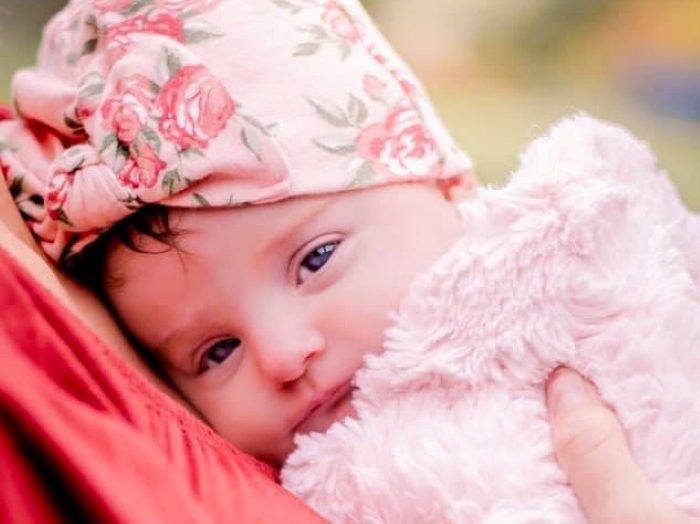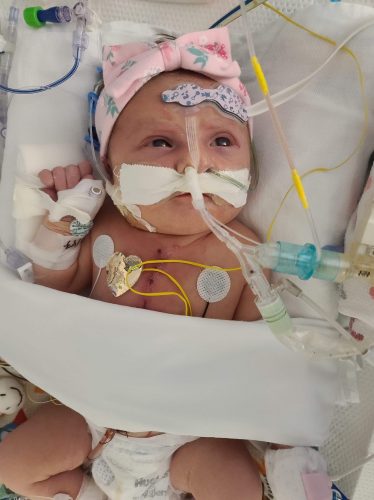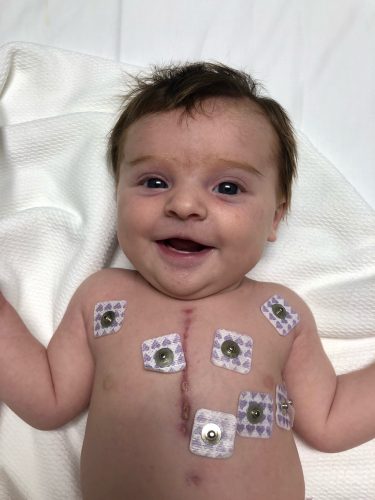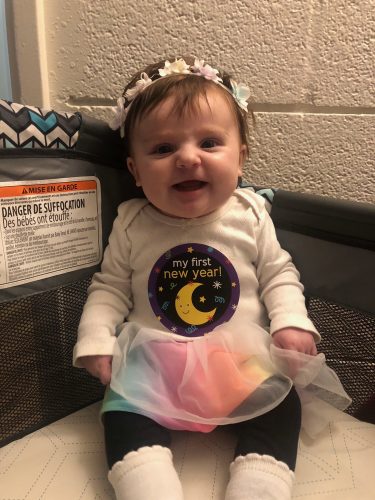 On New Year’s Eve of 2019, Sierra Landman learned she was pregnant with her first child.
On New Year’s Eve of 2019, Sierra Landman learned she was pregnant with her first child.
“We were so excited,” Landman said. “Then we learned that something wasn’t right with our baby’s heart.”
Nevaeh Landman was born on September 10, 2020 at Madigan Army Medical Center with hypoplastic left heart syndrome and immediately rushed to the Neonatal Intensive Care Unit (NICU), where she would stay for the next several days.
Hypoplastic left heart syndrome (HLHS) is when the left side of the heart is not fully developed. It is a rare and serious birth defect. Babies with HLHS need surgery in the first weeks of life. They will have a series of surgeries to redirect blood flow through their heart.
The Centers for Disease Control and Prevention (CDC) has estimated that each year about 1 in every 4,344 babies the United States are born with HLHS.

Survival rates continue to rise as surgery techniques and care after surgery improve. Today, an estimated 70% of infants who have the stage I repair, called a Norwood procedure, live to see early childhood. For children who survive to the age of 12 months, long-term survival is about 90%. The size and function of the right ventricle are important in determining the child’s outcome after surgery.
“When I first learned about her condition, I was terrified,” Landman said.
At merely 7 days old, Nevaeh was transported from Madigan to Seattle Children’s, and that same day, she underwent her first surgery.
“Nevaeh was born with one heart ventricle that was trying to do the work of two,” said Dr. Michael McMullan, chief of congenital cardiac surgery at Seattle Children’s, who performed Nevaeh’s surgery. “With the Norwood procedure, we reconstruct the the main artery that leaves the heart and create a connection between the heart and lungs so when the heart squeezes, the one ventricle is able to send blood every direction it needs to go.”
Children who receive the Norwood procedure at Seattle Children’s Heart Center have a 92% survival rate which McMullan says is due in great part to the Single Ventricle Program that focuses specifically on these patients and keeping them safe between hospitalizations and surgeries.
“Once kids make it out of the hospital after their first surgery, they are still at risk,” McMullan said. “That’s why the vigilance of our Single Ventricle team is so essential to these patients’ lives.”
Hitting milestones at home
 While there were a few road bumps in her recovery, Nevaeh was able to go home after spending a little over a month in the hospital.
While there were a few road bumps in her recovery, Nevaeh was able to go home after spending a little over a month in the hospital.
“The first month home was tough as we had to get used to monitoring her, giving her meds and certain types of food,” Landman said.
Like many families with children with HLHS, Seattle Children’s provided Nevaeh’s family with a home monitoring program called CHAMP (Cardiac High Acuity Monitoring Program) that helps monitor a child’s oxygen saturation and daily weight. This information is recorded to help provide the care team with early warning signs to problems and help make sure a child is growing and developing well.
Fortunately, Nevaeh made it easy for Landman.
“She couldn’t be an easier baby,” Landman said. “She’s such blessing.”
Nevaeh is very interactive, as Landman has observed, and she’s become quite the talker.
“She loves to talk and scream when she’s happy,” Landman said. “Doctors have told me that she’s well ahead of her age for her speech.”
From eating food three times a day to standing and trying to roll over; these are some of the milestones Nevaeh has reached in her four months of life thus far.
An unstoppable future
 With Nevaeh’s second surgery scheduled for this month, Landman is apprehensive but hopeful knowing how strong her daughter has become.
With Nevaeh’s second surgery scheduled for this month, Landman is apprehensive but hopeful knowing how strong her daughter has become.
“We have this beautiful little girl who is her own little person, who looks fine, and acts fine, and now we’re taking her back to the hospital—it feels like we have to start from day one again,” Landman said. “But I know she’s in good hands.”
Just like the hopes he has for all the children he treats; McMullan is optimistic for Nevaeh’s future.
“Keeping a child alive is one thing but giving a child a fulfilling and meaningful life is something that’s so much more important,” McMullan said. “It’s amazing to see so many of these kids, despite having serious heart defects, go on to live fantastic lives.”
Their journey has inspired Landman to share Nevaeh’s story and lend a hand to other families whose children have HLHS.
“I’m here to support other families, and I don’t want them thinking this is the end for their child, because it’s not,” Landman said. “It’s the start of this brand new, amazing, journey—a hard journey, but one that’s well worth the outcome.”
Landman can’t wait to see Nevaeh grow into her own person and doesn’t want to set limits to what she can achieve.
“The way I look at it, is if they can get through a heart surgery at just a few days old, and continue to go through surgeries in their life, there’s not a thing that can stop them — these are unstoppable kids,” she said.

